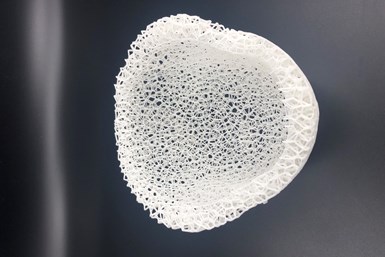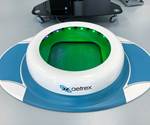EOS’ Digital Foam Flexible Lattice Polymer Enables Mass Customizations
Highly flexible lattice polymer material can be used to manufacture more comfortable, safer and lighter products that can be individually customized.

Digital Foam features a patented 3D printed flexible lattice design
EOS’ Digital Foam features a patented 3D printed flexible lattice design that enables a variety of customized consumer goods, including protective gear, high-performance, bespoke athletic footwear and more.
The material is well suited for any generatively 3D printed object which has a flexible grid-like structure or matrix (for example, a lattice), composed of open cells that are joined together in groups of differing characteristics. In basic terms, this covers any varying 3D printed lattice structures morphing into each other.
Whether applied to polymers or metals, the material covers the additive manufacturing of any three-dimensional object that has a lattice structure designed for predetermined flexibility characteristics with other filings.
The material was developed to enable unprecedented manufacturing customization opportunities or tailored products. Designers are able to make groups of cells, creating a lattice that can be engineered with varying levels of compressibility, the company says. One example is in athletic footwear, where consumers can purchase footwear tailored to their specific needs or desired performance characteristics. This includes shoe soles with varying compressibility in the heel, toe and arch areas, all made in one additively manufactured piece.
The company says this material enables manufacturers to provide product differentiation and improved product performance characteristics, including safety, comfort, lightweighting and “tuneability.”
Related Content
-
This Drone Bird with 3D Printed Parts Mimics a Peregrine Falcon: The Cool Parts Show #66
The Drone Bird Company has developed aircraft that mimic birds of prey to scare off problem birds. The drones feature 3D printed fuselages made by Parts on Demand from ALM materials.
-
How Norsk Titanium Is Scaling Up AM Production — and Employment — in New York State
New opportunities for part production via the company’s forging-like additive process are coming from the aerospace industry as well as a different sector, the semiconductor industry.
-
How Machining Makes AM Successful for Innovative 3D Manufacturing
Connections between metal 3D printing and CNC machining serve the Indiana manufacturer in many ways. One connection is customer conversations that resemble a machining job shop. Here is a look at a small company that has advanced quickly to become a thriving additive manufacturing part producer.














